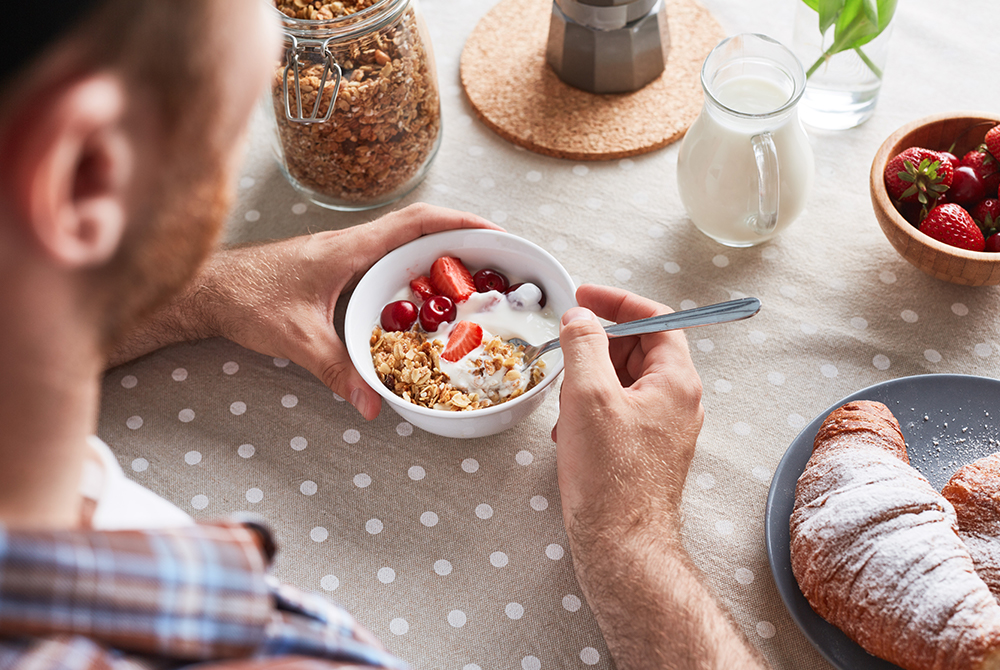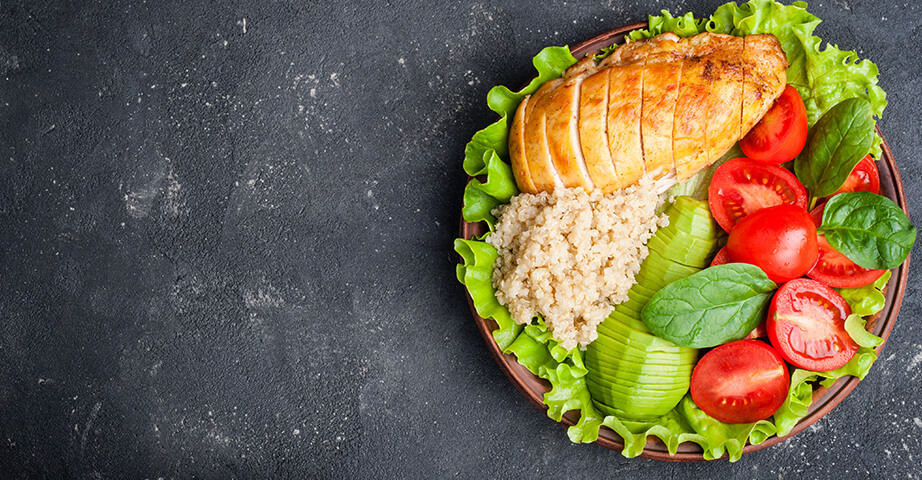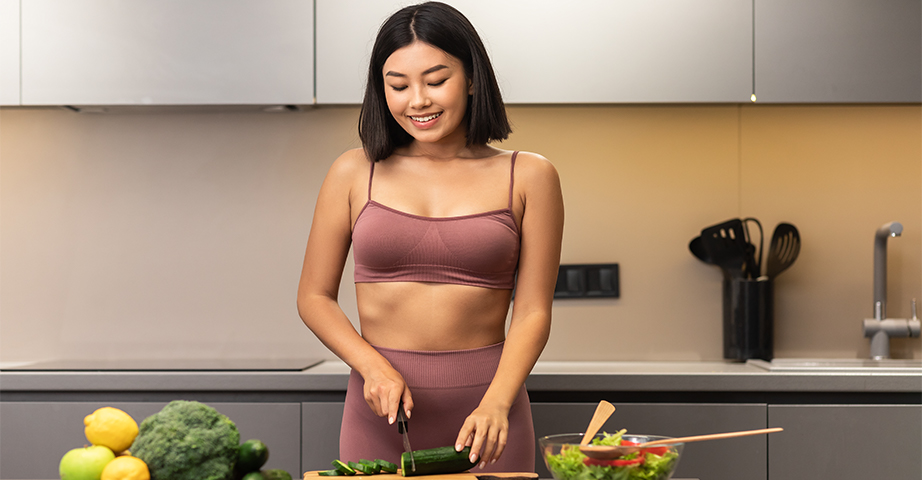Healthy breakfasts and fit dinners. What do you need to know about making nutritious meals?

How to eat to make breakfast healthy? What to cook for fit dinners to make them tasty, satisfactory and interesting? We are becoming increasingly aware of the impact of food on health. We want it to be fit and light. Simultaneously, the amount of information about diets as well as about what is healthy or not can be overwhelming.
That's why we're giving you a bunch of recipes for simple diet meals and explaining the principles that will allow you to plan healthy breakfasts and fit lunches yourself.
Healthy breakfasts - what's best to eat and when?
It is said that breakfast is the most important meal of the day and should be eaten up to an hour after waking up. Wait, not up to 30 minutes? Because the stomach digests itself from the inside. It should not be made up of carbohydrates? Like oatmeal with fruit. Wait, wait. And not made of protein and fat? Not avocado and bacon? There are a lot of myths about what breakfast should look like. That's why we're going to try and explain what a healthy breakfast is.
A healthy breakfast - what does it mean?
Firstly, a healthy breakfast has a different meaning for everyone. For one person it's sandwiches straight after waking up, for another it's scrambled eggs on bacon 3 hours after getting up. We are all different, our bodies have different needs, which is why it is extremely difficult to judge what exactly a healthy breakfast is. However, we do know how breakfast should not look like. A healthy breakfast cannot be loaded with simple sugars, which are rapidly digested and absorbed, raise blood glucose levels quickly, cause hunger 1-1.5 hours after the meal and increase the risk of lifestyle diseases, including atherosclerosis, diabetes and cancer. Therefore, a healthy breakfast is not white wheat bread with chocolate cream or breakfast cereal with milk. It's also not waffles with jam or yeast. Any meal that contains almost entirely carbohydrates is not a good idea for a healthy breakfast.
A healthy breakfast should include vegetables or fruit. However, vegetables should be more frequent. This is the one golden rule that is the same for everyone. Recipes for healthy breakfasts should include sources of protein, fat and carbohydrates. However, their proportions in the meal depend strictly on the health status, hormonal balance and figure goals of the individual person.
Breakfast vs scientific research
Breakfast does not need to be eaten right after waking up. Eating breakfast does not speed up your metabolism or make you consume more calories per day. Do not worry, your stomach does not digest itself from the inside. Never, under any non-pathological conditions. Its mucosa is perfectly adapted to fasting for hours, during which there is nothing but digestive juices in the stomach. There is no specific time by which breakfast must be eaten to be healthy.
People who have developed the habit of eating breakfast tend to have healthier eating habits in general. However, this is just a statistic. It does not mean that other healthy habits result from eating breakfast.
For people with carbohydrate disorders and those losing weight, protein-fat breakfasts (eggs, avocado, meat) with a high restriction of carbohydrates (bread, cereals) are much healthier. They allow much better control of blood glucose and insulin levels.
Eat when you are hungry. If you wake up with a strong feeling of hunger, eat breakfast straight away. If you feel nauseous at the thought of eating in the first hours after getting up, eat breakfast when you feel hungry. Forcing yourself to eat because someone has told you to eat 5 meals at a particular time, disrupts your natural hunger and satiety control mechanisms.
Recommended products
The idea for a healthy breakfast - omelette with a tortilla wrap
An omelette in a tortilla wrap is one of our favourite healthy breakfasts. It introduces some variety and is still quick and easy. How to prepare them?
Put 3 eggs into a bowl, add salt, pepper and cumin if you like, and stir. Pour the eggs into a heated frying pan with a little fat and fry until the omelette is almost completely cooked. It's better to use a bigger frying pan so that it's not too thick. Then place a tortilla pancake on top of it and flip it to the other side using a wide spatula. Fry the side for 2-3 minutes until it becomes crispy. Meanwhile, place the cream cheese, ham and your favourite vegetables on top of the omelette. Fold both edges of the pancake with the omelette into the middle and flip over again, so that the edges connect better. Cut the pancake in two, if you want it to look nicer on the plate.
Healthy breakfast recipes - fluffy sweet omelette
A fluffy omelette with coconut flour is the perfect healthy breakfast for people who like sweet things in the morning but don't want to raise their blood sugar levels rapidly. Additionally, it's a very simple recipe that's easy to incorporate into your daily menu.
Crack 3 eggs into a bowl, and scramble with a spatula. Add some baking soda - at the tip of a teaspoon - and a tablespoon of coconut flour. Scramble again until the coconut flour and eggs form a thick mass. Pour the omelette into a pan with a little fat. A smaller pan will work better this time so that the omelette is thicker. Fry on both sides for approx. 2 minutes, until browned. Place on a plate. Spread the omelette with sugar-free peanut butter, sprinkle with coconut shavings and raspberries or other favourite fruit.
Quick, healthy breakfasts
Quick and healthy breakfasts are also classics that are well known to everyone. For a meal to be healthy, it doesn't have to be fancy. It only needs to not be overloaded with simple sugar and highly processed products of questionable composition. Quick, healthy breakfasts are always:
- scrambled, fried and boiled eggs accompanied by vegetables, with or without bread - depending on your needs;
- sausages with nearly 100% meat content + vegetables,
- wholemeal sandwiches with various protein and fatty toppings, e.g. mackerel or salmon paste, avocado paste, hummus and olives, quark,
- oatmeal, but not with fruit alone, with the addition of protein and fat sources, e.g. nuts, pumpkin and sunflower seeds, chia seeds, and peanut butter.
Fit dinner - when does dinner become dietary?
A fit dinner can be incredibly tasty and satisfying. It doesn't have to be a grilled chicken breast, some rice and a salad. There are lots of options to make a dinner fit, i.e. less calorific than a classic one. To achieve it, you need to use less fat during preparation, avoid breadcrumbs, roux, deep frying and sugar in the meal (the hidden one too, e.g. in ketchup!) and reduce the number of starchy side dishes - pasta, porridge, rice, potatoes. Portion sizes and proportions of protein and carbohydrate sources, need to be matched. Do not forget about the vegetables! They should be an ingredient in every fit dinner.
Where can you get ideas for fit dinners? First of all, think about what dishes you like the most and whether they can be 'slimmed down. If you try to stop eating your favourite meals overnight and become an encyclopaedia of fit recipes, you will get discouraged rather quickly. When you're slimming down, calorie-counting apps are a great help. Some of them also include databases of ready-made ideas for fit meals. And, of course, a search engine or Instagram. The internet is full of recipes for fit dinners. Search, test and create your own database of favourite meals.

Fit recipes for dinner - homemade kebab in a tortilla
Who doesn't love a kebab? Just the bun. And the sauce. Not a fit meal, definitely. We swap the bun for a tortilla wrap, make the sauce ourselves to cut down on fat and this way, without much effort, we have a fit dinner idea. The recipe is extremely simple.
Cut the chicken breast into 3-4 cm strips, fry in a teaspoon of oil, and season. Prepare garlic sauce - mix thick natural yoghurt with garlic, a pinch of salt and herbs de Provence. Slice the vegetables - cabbage, tomato, tinned cucumber, olives or other favourites. Warm the tortilla wraps in the oven, but so that they are still soft and pliable. Now fold it in half and then in half again to form a triangle shape. Pin the side of the tortilla with a toothpick. The open tortilla should be shaped like a cone. You can wrap the bottom of the pancake in aluminium foil for convenience. Brush the wrap with sauce, layering vegetables, sauce and meat. Done. This fit kebab recipe is great because the kebab comes out very large and has less than 400 kcal.
Ideas for fit dinners - pork chop with cabbage and porridge
To change the image of fit dinners as being modern and chicken-based, we show a recipe that is very close to traditional Polish dishes. It is only "slimmed down". Can pork chop in cabbage be a fit dinner? Yes, it can!
Dice onions (1 pc), fry in oil (1 tbsp). Transfer to a pot. In the same pan, fry the diced lean, meatless pork loin until browned. Transfer to the pot and cover with water. Add bay leaf, allspice, salt, pepper, sweet paprika and thyme. Then add the shredded white cabbage (2 large handfuls), sliced carrots (1 piece) and thickly diced red peppers (1 piece). Simmer the whole thing for about 45 minutes. Serve with buckwheat groats. Control the amount of buckwheat so that it is still fit!
Diet meals - practical tips on how to plan and cook diet meals
Although the word 'diet' refers to a way of eating in general and a way of life, in Polish it has become accepted that 'dietetic' is something that will work well on a weight-loss diet. Dietary means, in the first instance, less caloric than the standard one. However, let's not forget that dieting is not only about calories, so a diet dish is also a healthy dish.
As you have already noticed by checking our sample recipes for diet dishes, these dishes are very far from steamed fish, preferably without salt, and raw vegetables. For a very long time, this type of dish was promoted as the best for weight loss and healthy, because it is fat-free, salt-free and sugar-free. Today, fortunately, enriched by decades of scientific research, we know that dietetic dishes do not have to be unsatisfying, tasteless and low in fat. So what should they be? What do you need to know to plan and cook diet meals without any problems?
Use recipe databases with calorie content calculations
Before you learn the approximate calorie content of the dishes you are cooking, recipe databases for dietetic dishes become your essential tool. These must include the calculated calorie and macronutrient content per serving of the dish. This will make it easy for you to assess whether the dish is for you and how much you can eat to stay within your calorie targets. Diet dishes are also available on app bases for counting calories from meals. It is a huge convenience when composing meals
Buy food that is as little processed as possible
When we buy unprocessed or low-processed foods, e.g. raw meat, raw or frozen vegetables, eggs, we have much more control over the calorie content and composition of the meal that we are preparing than when we buy a ready-made dish or ready-made semi-finished products. For example, spaghetti sauce from a jar contains sugar in large quantities. On a diet, we don't want empty calories, so it is better to make the pasta sauce ourselves, using tomato puree without any added ingredients and canned tomatoes.

Check the sugar content of your products
Yoghurts, flavoured buttermilk or dairy drinks are some of the products with the highest added sugar content. Often, flavoured yoghurts contain 12-15g of sugar per 100 g. That's as much as 3 teaspoons! There are sugar-free options available on the shelves which are much better to reach for. However, dairy products naturally contain sugars. The norm is 4-5 g/100 g.
Sugar is not only hidden in dairy products. It is practically always in ketchup, ready-made sauces, muesli, breakfast cereals, cereal and protein bars. In extreme cases, even in sausages. Sugar in the ingredients list should always be a wake-up call to take a closer look at the product, a zwykle do zrezygnowania z niego.
Treat 'fit' and 'light' carefully
Foods labelled as "fit" or reduced-fat are unfortunately very often poorly formulated. Removing fat from a product most often results in the need to add a fat substitute to maintain the right consistency, which is not what you want from diet food.
BUT! There are good reduced-fat cheeses on shop shelves - mozzarella, yellow cheeses, salad cheeses. There are products where the sugar is replaced with health-neutral sweeteners. These products are your friend in dietary dishes. Therefore, always read the ingredients.
Save your calories
Limit meals that are high in calories in a small volume. For example, mouldy cheeses. Dried cabanas. Cream cheese. These are not bad products. But at the same time, they don't make cooking diet meals any easier. Diet meals are all about making them as big as possible while maintaining the indicated calories. The best friends of people on a diet are vegetables, cottage cheese, country cheese, skyr and lean meat. They are very filling and have very few calories. If a product has up to 100 kcal in 100 g, it will be ideal for diet recipes.
Don't drink calories
Juices, fizzy drinks, sweet coffee... . Drinks contain precious calories that you won't eat. They do not fill the stomach for long. They don't cause satiety, and they count the same as calories from food. Therefore, try to make your drinks calorie-free. Then you can eat more from your diet meals.
